I got my masters degree online from Full Sail University in Educational Media Design and Technology. This was a hugely positive experience for me. I felt MORE connected to my instructors, my learning, and my classmates than I ever did in a face to face class. I have taken online classes after this experience and those were a vastly different experience. In some online classes I have taken I felt isolated, disconnected, and frustrated. One experience motivated me to do my best and be creative. The other caused me to not care, turn in whatever, and I had to force myself to complete assignments.
I saw this on Twitter from a student:
Google Classroom is just a sad excuse for some teachers to assign work without having to interact with their students.
— Dana Faye (@Dana_Dziedzic) September 11, 2015
Connected Learning
One criticism I hear from some people about students using their phones and technology is that it isolates us. I do not think this is true, I am more connected with people because I use digital tools to collaborate and interact with others. I do not use my computer to isolate myself, I share and interact with almost everything I am doing. This is intentional.
Connectivism is a learning theory that contends that we learn through our interactions and connections. Particularly in a digital age, this becomes more relevant.
Plan for Interactions
When creating digital assignments, it is important to plan (design) interactions into the tasks. Filling out worksheets online or annotating PDF’s can be a non engaging activity. Using a digital platform such as Google Classroom to pass out papers and collect it is not the best use of the platform. Google Classroom, and other online tools, can help students to be more connected to their learning. The task has to change from “fill this out” to “collaborate,” “discuss,” “crowdsource,” “interview,” “share,” “comment on other students,” etc…
Online tools give students a change to have their voice and opinion heard. This was challenging in a classroom without technology. A classroom discussion can only hear from a couple of students at a time. Digital discussions allow every student to have their ideas be heard. Every student in the class can hear from every student.
Look at your digital tasks. Do they ask students to engage and connect? If not, consider designing a different activity.










1 thought on “Online Tools – Make Learning MORE Connected”
In fact, online interaction has significantly widened the scope of my collaboration. It provides challenging puzzles with which one can assist PLN members. It provides alternative viewpoints from beyond your physical location that can be very different. It can provide an avenue for students who would normally not participate in classroom discussion to do so. It provides time to think before interjecting a comment to a discussion. Like any form of instruction, online delivery can be good or not so good. Sad that this student experienced the latter.